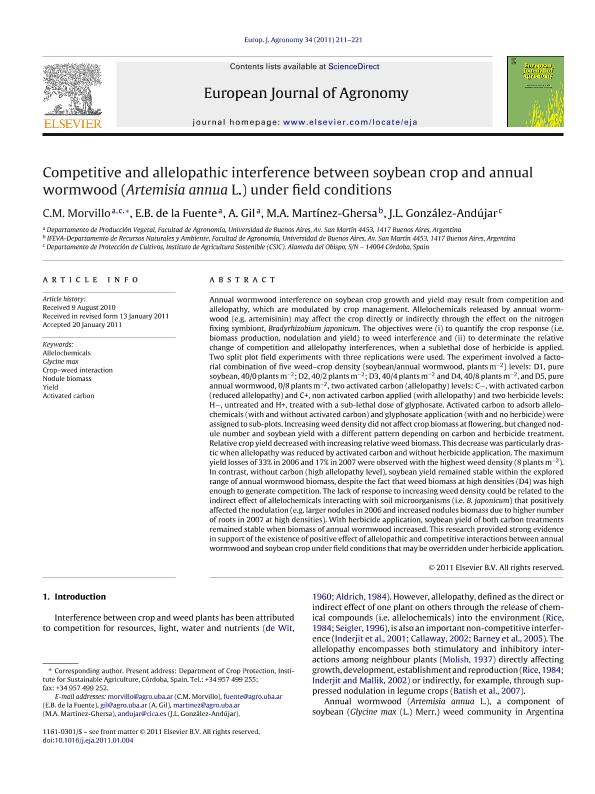Mostrar el registro sencillo del ítem
dc.contributor.author
Morvillo, Claudia Mariela

dc.contributor.author
de la Fuente, Elba Beatriz

dc.contributor.author
Gil, Alejandra

dc.contributor.author
Martinez-Ghersa, Maria Alejandra

dc.contributor.author
González Andújar, J. L.
dc.date.available
2019-03-11T20:44:21Z
dc.date.issued
2011-05
dc.identifier.citation
Morvillo, Claudia Mariela; de la Fuente, Elba Beatriz; Gil, Alejandra; Martinez-Ghersa, Maria Alejandra; González Andújar, J. L.; Competitive and allelopathic interference between soybean crop and annual wormwood (Artemisia annua L.) under field conditions; Elsevier Science; European Journal of Agronomy; 34; 4; 5-2011; 211-221
dc.identifier.issn
1161-0301
dc.identifier.uri
http://hdl.handle.net/11336/71440
dc.description.abstract
Annual wormwood interference on soybean crop growth and yield may result from competition and allelopathy, which are modulated by crop management. Allelochemicals released by annual wormwood (e.g. artemisinin) may affect the crop directly or indirectly through the effect on the nitrogen fixing symbiont, Bradyrhizobium japonicum. The objectives were (i) to quantify the crop response (i.e. biomass production, nodulation and yield) to weed interference and (ii) to determinate the relative change of competition and allelopathy interferences, when a sublethal dose of herbicide is applied. Two split plot field experiments with three replications were used. The experiment involved a factorial combination of five weed-crop density (soybean/annual wormwood, plantsm-2) levels: D1, pure soybean, 40/0plantsm-2; D2, 40/2plantsm-2; D3, 40/4plantsm-2 and D4, 40/8plantsm-2, and D5, pure annual wormwood, 0/8plantsm-2, two activated carbon (allelopathy) levels: C-, with activated carbon (reduced allelopathy) and C+, non activated carbon applied (with allelopathy) and two herbicide levels: H-, untreated and H+, treated with a sub-lethal dose of glyphosate. Activated carbon to adsorb allelochemicals (with and without activated carbon) and glyphosate application (with and no herbicide) were assigned to sub-plots. Increasing weed density did not affect crop biomass at flowering, but changed nodule number and soybean yield with a different pattern depending on carbon and herbicide treatment. Relative crop yield decreased with increasing relative weed biomass. This decrease was particularly drastic when allelopathy was reduced by activated carbon and without herbicide application. The maximum yield losses of 33% in 2006 and 17% in 2007 were observed with the highest weed density (8plantsm-2). In contrast, without carbon (high allelopathy level), soybean yield remained stable within the explored range of annual wormwood biomass, despite the fact that weed biomass at high densities (D4) was high enough to generate competition. The lack of response to increasing weed density could be related to the indirect effect of allelochemicals interacting with soil microorganisms (i.e. B. japonicum) that positively affected the nodulation (e.g. larger nodules in 2006 and increased nodules biomass due to higher number of roots in 2007 at high densities). With herbicide application, soybean yield of both carbon treatments remained stable when biomass of annual wormwood increased. This research provided strong evidence in support of the existence of positive effect of allelopathic and competitive interactions between annual wormwood and soybean crop under field conditions that may be overridden under herbicide application. © 2011 Elsevier B.V.
dc.format
application/pdf
dc.language.iso
eng
dc.publisher
Elsevier Science

dc.rights
info:eu-repo/semantics/openAccess
dc.rights.uri
https://creativecommons.org/licenses/by-nc-sa/2.5/ar/
dc.subject
Activated Carbon
dc.subject
Allelochemicals
dc.subject
Crop-Weed Interaction
dc.subject
Glycine Max
dc.subject
Nodule Biomass
dc.subject
Yield
dc.subject.classification
Agricultura

dc.subject.classification
Agricultura, Silvicultura y Pesca

dc.subject.classification
CIENCIAS AGRÍCOLAS

dc.title
Competitive and allelopathic interference between soybean crop and annual wormwood (Artemisia annua L.) under field conditions
dc.type
info:eu-repo/semantics/article
dc.type
info:ar-repo/semantics/artículo
dc.type
info:eu-repo/semantics/publishedVersion
dc.date.updated
2019-03-08T20:17:33Z
dc.journal.volume
34
dc.journal.number
4
dc.journal.pagination
211-221
dc.journal.pais
Países Bajos

dc.journal.ciudad
Amsterdam
dc.description.fil
Fil: Morvillo, Claudia Mariela. Consejo Nacional de Investigaciones Científicas y Técnicas; Argentina. Universidad de Buenos Aires. Facultad de Agronomía. Departamento de Producción Vegetal; Argentina
dc.description.fil
Fil: de la Fuente, Elba Beatriz. Consejo Nacional de Investigaciones Científicas y Técnicas; Argentina. Universidad de Buenos Aires. Facultad de Agronomía. Departamento de Producción Vegetal; Argentina
dc.description.fil
Fil: Gil, Alejandra. Consejo Nacional de Investigaciones Científicas y Técnicas; Argentina. Universidad de Buenos Aires. Facultad de Agronomía. Departamento de Producción Vegetal; Argentina
dc.description.fil
Fil: Martinez-Ghersa, Maria Alejandra. Consejo Nacional de Investigaciones Científicas y Técnicas. Oficina de Coordinación Administrativa Parque Centenario. Instituto de Investigaciones Fisiológicas y Ecológicas Vinculadas a la Agricultura. Universidad de Buenos Aires. Facultad de Agronomía; Argentina
dc.description.fil
Fil: González Andújar, J. L.. Consejo Superior de Investigaciones Científicas; España
dc.journal.title
European Journal of Agronomy

dc.relation.alternativeid
info:eu-repo/semantics/altIdentifier/doi/https://dx.doi.org/10.1016/j.eja.2011.01.004
dc.relation.alternativeid
info:eu-repo/semantics/altIdentifier/url/https://www.sciencedirect.com/science/article/pii/S1161030111000062
Archivos asociados
